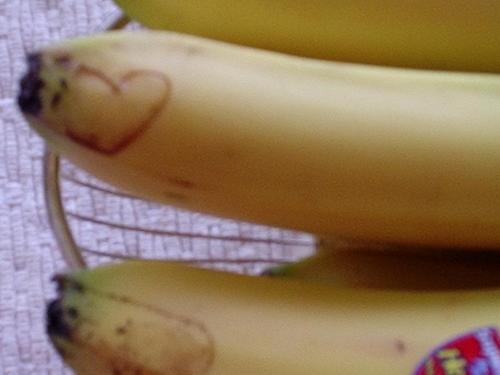Sunday I bought a bunch of Bananas, Monday I went to take one of the
more ripe ones off the bunch and I saw this HEART shape on it. The
sticker on the bunch said "Super Food For Your HEART"
Had to take a picture to show you.

Nature gives us many "messages" more are below. Have a heart-food day. Ana
The banana plant is not a tree. It is actually the world's largest herb!
Nature left us great clues as to what foods help what part of our body!
like the human eye. The pupil, iris and radiating lines look just like
the human eye... and YES, science now shows carrots greatly enhance
blood flow to and function of the yes.
Grapes hang
in a cluster that has the shape of the heart. Each grape looks like a
blood cell and all of the research today shows grapes are also profound
heart and blood vitalizing food.
like a little brain, a left and right hemisphere, upper cerebrums and
lower cerebellums. Even the wrinkles or folds on the nut are just like
the neo-cortex. We now know walnuts help develop more than three (3)
dozen neuron-transmitters for brain function.
many more look just like bones. These foods specifically target bone
strength. Bones are 23% sodium and these foods are 23% sodium. If you
don't have enough sodium in your diet, the body pulls it from the
bones, thus making them weak. These foods replenish the skeletal needs
of the body
the health and function of the womb and cervix of the female - they
look just like these organs. Today's research shows that when a woman
eats one avocado a week, it balances hormones, sheds unwanted birth
weight, and prevents cervical cancers. And how profound is this? It
takes exactly nine (9) months to grow an avocado from blossom toripened
fruit. There are over 14,000 photolytic chemical constituents of
nutrition in each one of these foods (modern science has only studied
and named about 141 of them).
full of seeds and hang in twos when they grow. Figs increase the
mobility of male sperm and increase the numbers of Sperm as well to
overcome male sterility.
look just like the mammary glands of the female and actually assist the
health of the breasts and the movement of lymph in and out of
thebreasts.
like the body's cells. Today's research shows onions help clear waste
materials from all of the body cells. They even produce tears which
wash the epithelial layers of the eyes. A workingcompanion, Garlic, also helps eliminate waste materials and dangerous free radicals from the body.

The
true origin of Bananas, world's most popular fruit, is found
in the region of Malaysia. By way of curious visitors, bananas
traveled from there to India where they are mentioned in
the Buddhist Pali writings dating back to the 6th century
BCE. In his campaign in India in 327 BCE, Alexander the
Great relished his first taste of the banana, an usual fruit
he saw growing on tall trees. He is even credited with bringing
the banana from India to the Western world. According to
Chinese historian Yang Fu, China was tending plantations
of bananas in 200 CE. These bananas grew only in the southern
region of China and were considered exotic, rare fruits
that never became popular with the Chinese masses until
the 20th century.
Eventually, this tropical fruit reached Madagascar, an
island off the southeastern coast of Africa. Beginning in
650 CE Islamic warriors traveled into Africa and were actively
engaged in the slave trade. Along with the thriving business
in slave trading, the Arabs were successful in trading ivory
along with abundant crops of bananas. Through their numerous
travels westward via the slave trade, bananas eventually
reached Guinea, a small area along the West Coast of Africa.
By 1402 Portuguese sailors discovered the luscious tropical
fruit in their travels to the African continent and populated
the Canary lslands with their first banana plantations.
Continuing the banana's travels westward, the rootstocks
were packed onto a ship under the charge of Tomas de Berlanga,
a Portuguese Franciscan monk who brought them to the Caribbean
island of Santo Domingo from the Canary Islands in the year
1516. It wasn't long before the banana became popular throughout
the Caribbean as well as Central America. Arabian slave
traders are credited with giving the banana its popular
name. The bananas that were growing in Africa as well as
Southeast Asia were not the eight-to-twelve-inch giants
that have become familiar in the U.S. supermarkets today.
They were small, about as long as a man's finger. Ergo the
name banan, Arabic for finger. The Spaniards, who saw a
similarity to the plane tree that grows in Spain, gave the
plantain its Spanish name, platano.
It was almost three hundred and fifty years later that
Americans tasted the first bananas to arrive in their country.
Wrapped in tin foil, bananas were sold for 10 cents each
at a celebration held in Pennsylvania in 1876 to commemorate
the hundredth anniversary of the Declaration of Independence.
Instructions on how to eat a banana appeared in the Domestic
Cyclopaedia of Practical Information and read as follows:
"Bananas are eaten raw, either alone or cut in slices
with sugar and cream, or wine and orange juice. They are
also roasted, fried or boiled, and are made into fritters,
preserves, and marmalades."


